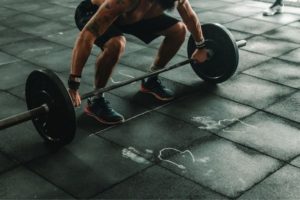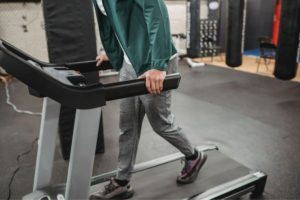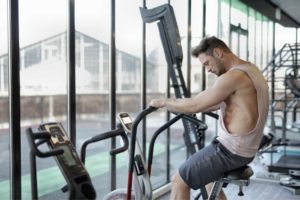Hernias frequently occur in individuals who lift heavy weights, including bodybuilders, powerlifters, and those who engage in strenuous physical activities inside and outside the gym.

Athletes and bodybuilders dread being sidelined by this injury, as it hinders their progress and growth.
For these individuals, resuming training after undergoing hernia surgery may be daunting. But fear not.
You can return to your beloved exercise routine and improve your physique with proper care and attention.
Here’s what you need to know about bodybuilding after hernia surgery:
Invest in Your Diet
Following a healthy diet after hernia surgery is crucial for a speedy recovery and setting a solid foundation for post-surgery bodybuilding workouts.
Here are some tips to help you optimize your nutrition plan after hernia surgery:
Eat Enough Protein and Complex Carbohydrates
To help with recovery and improve muscle growth, it’s important to incorporate enough protein into your daily diet.
With proteins as the building block for muscle development, a daily intake of 1.2-1.6 grams per kilogram of body weight is recommended.
You can include protein sources like eggs, fish, dairy, lean meats, legumes, poultry, and soy products into your diet.
Similarly, carbohydrates cannot be neglected. They provide the energy necessary to fuel workouts and support muscle growth.
Opting for complex carbohydrates like whole grains, fruits, and vegetables is advised since they provide essential nutrients and fiber.
Stay Hydrated
Maintaining good hydration is a must for good healthy living. Taking enough water before, during, and after exercise is essential.
Water offers many benefits, such as temperature regulation, joint lubrication, and nutrient transportation.
The human body only operates at an optimal level when adequately hydrated. With poor hydration comes dizziness, muscle cramps, and other negative symptoms.
There are no fixed guidelines for how much water to drink during exercise because individual requirements vary.
Factors such as your sweat rate, environmental conditions of heat and humidity, and intensity and duration of exercise must be considered when determining your hydration needs.
Eat Fresh Fruits and Vegetables
Incorporate fresh fruits and fruit juice into your diet to promote faster healing.
Steer clear of gas-inducing foods like cabbage, cauliflower, broccoli, brussels sprouts, corn, green peppers, sauerkraut, and rutabagas.
Ensure that all vegetables in your diet plan are cooked thoroughly.
Start Slow
To avoid setbacks in your recovery journey, it’s crucial to take a gradual approach when bodybuilding after hernia surgery.
Don’t rush into the same weightlifting routine you had before your injury.
Your body needs time to heal after surgery. Rushing back into your usual routine can cause complications and set you back.
Start with low-intensity exercises, such as walking or light resistance training, and gradually increase the intensity.

One Month Post Surgery
You can start adding light exercises and stretches to your routine after four weeks of recovery from hernia surgery. Focus on building core strength through your workout routine.
A well-designed training program after an injury like a hernia should prioritize core training.
Strengthening your core muscles can help prevent the recurrence of the injury and maintain your recovery progress.
When bodybuilding after hernia surgery, starting with your core is essential to improve your overall functional performance.
According to a study published in Isokinetics and Exercise Science, men who underwent three-hour-long Pilates sessions weekly for two months saw significant improvements in postural stability tests.
Check out these three workouts designed to help strengthen and build your core base:
- Plank: A fantastic starting exercise to engage your core is supporting your body weight on your toes and forearms. To do this, assume a press-up position, but instead of resting on your hands, rest on your forearms. Keep your back straight, tighten your abs and glutes, and hold the position without allowing your hips to slack.
- Glute Bridge: Building a robust set of glutes is crucial for a strong core, yet this muscle group is frequently neglected. Strengthening your glutes helps to build a better physical appearance. To begin this core-strengthening exercise, lay flat on the floor and bend your knees. Drive your heels into the ground while elevating your hips as high as possible. Pause for a second, then lower yourself to the starting position.
- Dead Bug: Dead bugs are excellent for core bodybuilding after hernia surgery, especially for beginners. This is because they’re straightforward and a secure way to evaluate your core strength. To do this, go on your back, and raise your legs into a tabletop position, placing your knees at a 90-degree angle. Gently put your hands on your chest. When one arm and the opposite leg are a few inches above the floor, slowly drop both simultaneously. Return to the starting position and alternate with the other arm and leg.
Two Month Post Surgery
Once you’ve had hernia surgery, it’s best to wait two months before gradually reintroducing low-impact bodybuilding into your routine.
Low-impact exercises offer a lot of benefits to the human body.
They help to boost recovery from surgery trauma, strengthen weak muscles from periods of inactivity, and help to enhance mobility and endurance.

During the following months, please pay attention to your body and only add new exercises that don’t cause pain or discomfort. Some low-impact exercises include:
- TRX Bands: Suspension training straps, commonly known as TRX bands, offer a highly effective method for enhancing strength and flexibility post-surgery. These bands utilize bodyweight exercises to target multiple muscle groups with resistance while using gravity for extra support. TRX bands are adjustable, allowing users to customize the difficulty of bodybuilding after hernia surgery based on their body position and strap length, thus making it safer to progress at their own pace.
- Cycling: For those recovering from hernia surgery, cycling is the perfect low-impact exercise that helps improve cardiovascular fitness and strengthen muscles without putting undue stress on the joints. Cycling can be adjusted to suit any intensity level, making it suitable for all postoperative patients. You can start with shorter rides at a comfortable pace, then gradually increase the duration and intensity as your stamina improves. With cycling, you can safely and progressively build up your physical endurance after surgery.
- Walking: Walking is one of the best low-impact workouts for post-surgery recovery. It can be done anywhere, is gentle on your joints, and doesn’t need special equipment. Walking helps maintain fitness levels while managing pain or fatigue, improving blood circulation and oxygenation of critical organs. It doesn’t cost a penny, making it a convenient option for bodybuilding after hernia surgery.
- Weight Lifting: Weightlifting is an excellent, low-impact exercise to support post-surgery recovery. It can support enhanced endurance and mobility while strengthening muscles weakened from inactivity. To optimize weight training after surgery, it’s crucial to focus on using lighter weights that won’t excessively burden the body rather than heavier ones. By selecting a weight range suitable for your healing body, you can progressively build your strength without causing unnecessary stress.
After hernia repair, patients are typically advised to avoid lifting anything weighing over fifteen pounds for four weeks.
However, most patients can resume heavy lifting and strenuous bodybuilding after hernia surgery in a few months.
Patients who have undergone laparoscopic inguinal surgery or laparoscopic hernia repair can typically resume weightlifting and gym activities within two to three months.
For larger incisional and umbilical hernias, waiting for two months before engaging in these activities is advised.
Conclusion
Recovering from hernia surgery can be daunting, especially for bodybuilders and athletes who dread being sidelined by the injury.
However, they can return to their exercise routine and improve their physique with proper care and attention.
A healthy diet, starting slow, and gradually increasing the intensity of the workout is crucial in recovery.
After four weeks, incorporating light bodybuilding to strengthen the core muscles is recommended.
After two months, low-impact exercises such as TRX bands and cycling can be added.
Listening to your body and not rushing into old routines is critical to preventing setbacks and promoting long-term progress.

Some people collect expensive old cars, and I’m into collecting bikes. I have 15 different bikes: special mountain bikes, sportbikes, professional, amateur, and city bikes. My friends and colleagues call me a ‘bike expert’ because I give advice on how to choose the right bike.
I’m also a massive fan of gym culture and heavyweight workouts. I met Alan at my local gym, and we’ve become friends quite soon. His idea of starting a sports blog seemed interesting to me, so I agreed to help.





